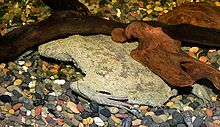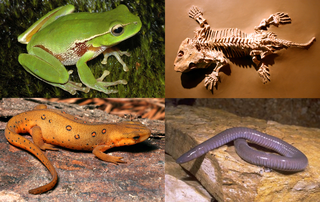
Amphibians are ectothermic, tetrapod vertebrates of the class Amphibia. All living amphibians belong to the group Lissamphibia. They inhabit a wide variety of habitats, with most species living within terrestrial, fossorial, arboreal or freshwater aquatic ecosystems. Thus amphibians typically start out as larvae living in water, but some species have developed behavioural adaptations to bypass this.
A tadpole is the larval stage in the life cycle of an amphibian. Most tadpoles are fully aquatic, though some species of amphibians have tadpoles that are terrestrial. Tadpoles have some features that may not be found in adult amphibians such as a lateral line, gills, and tails. As they undergo metamorphosis, the diet of tadpoles changes and they will start to breathe air.
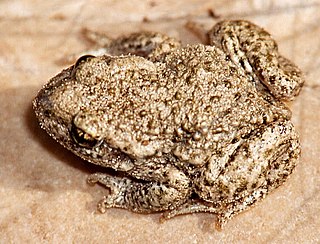
The Alytidae are a family of primitive frogs. Their common name is painted frogs or midwife toads. Most are endemic to Europe, but there are also three species in northwest Africa, and a species formerly thought to be extinct in Israel.

The Pipidae are a family of primitive, tongueless frogs. The 41 species in the family Pipidae are found in tropical South America and sub-Saharan Africa.

The glass frogs are frogs of the amphibian family Centrolenidae. While the general background coloration of most glass frogs is primarily lime green, the abdominal skin of some members of this family is transparent and translucent. The internal viscera, including the heart, liver, and gastrointestinal tract, are visible through the skin, hence the common name is given as glass frog. Glass frogs are arboreal, meaning they mainly live in trees, and only come out for mating season.

The Rhinophrynidae are a family of frogs containing one extant genus, the monotypic Rhinophrynus, and a number of fossil genera. The family is sometimes known as the Mexican burrowing toads or simply burrowing toads.
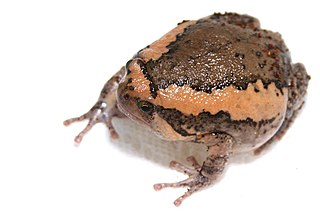
Kaloula is a genus of microhylid frogs found in southern and eastern Asia. They are sometimes known as the Asian narrowmouth toads.
Pipa aspera, the Albina Surinam toad, is a species of frog in the family Pipidae found in French Guiana, Suriname, and possibly Brazil. Its natural habitats are subtropical or tropical moist lowland forests, rivers, freshwater marshes, and intermittent freshwater marshes. The color of this species is a reddish-brown to a brownish-black, noticed on the dorsal part of its body. The weights of females range between 5 and 12 grams, and males between 4 and 7 grams, noting that females are usually significantly larger.

Carvalho's Surinam toad is a species of frog in the family Pipidae endemic to Brazil. Its natural habitats are subtropical or tropical dry forests, dry savanna, moist savanna, subtropical or tropical dry shrubland, subtropical or tropical moist shrubland, freshwater marshes, ponds, and aquaculture ponds. It is threatened by habitat loss.
Myers' Surinam toad is a species of frog in the family Pipidae found in Panama and possibly Colombia. Its natural habitats are subtropical or tropical moist lowland forests and rivers. It is threatened by habitat loss.
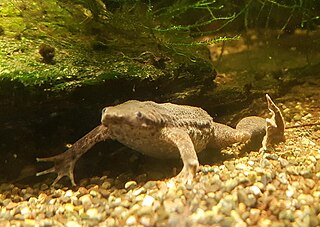
Pipa parva, is a species of frog in the family Pipidae. It is found in northwestern Venezuela and northeastern Colombia, mainly in the Maracaibo Basin. There is an introduced population in the Lake Valencia Basin in northern Venezuela.
Pipa snethlageae, the Utinga Surinam toad, is a species of frog in the family Pipidae found in Brazil, Colombia, Peru, and possibly Venezuela. Its natural habitats are subtropical or tropical moist lowland forests and freshwater marshes. It is threatened by habitat loss.
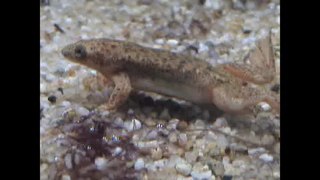
Merlin's dwarf gray frog, or Merlin's clawed frog, is a species of frog in the family Pipidae. It is monotypic within the genus Pseudhymenochirus. It is found in southern Guinea-Bissau, western Guinea, and southern Sierra Leone.
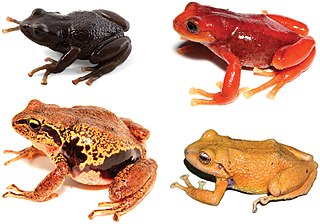
The Craugastoridae, or fleshbelly frogs, are a family of New World direct-developing frogs. As delineated here, following the Amphibian Species of the World, it is a large family containing 857 species. They are found from the southern United States southwards to Central and South America.
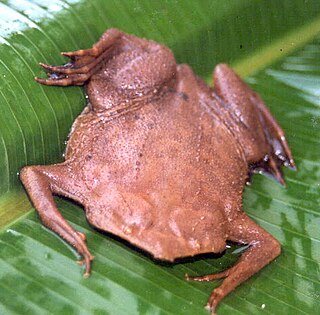
The common Surinam toad or star-fingered toad is a species of frog in the family Pipidae found in Bolivia, Brazil, Colombia, Ecuador, French Guiana, Guyana, Peru, Suriname, Trinidad and Tobago, and Venezuela. Its natural habitats are subtropical or tropical moist lowland forests, subtropical or tropical swamps, swamps, freshwater marshes, and intermittent freshwater marshes. It is threatened by habitat loss.
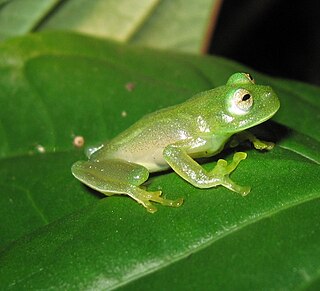
Vitreorana is a genus of glass frogs that are native to South America, from the Atlantic Forest of Brazil and Argentina to the Amazon rainforest of Colombia and Ecuador and to the Venezuelan Coastal Range and the Guianas.
Celsiella is a small genus of glass frogs endemic to Venezuela. It was established in 2009 and named in honour of Josefa Celsa Señaris, nicknamed "Celsi", a Venezuelan herpetologist who had worked with glass frogs.
Ceuthomantis is a small genus of craugastorid frogs, also treated as comprising their own monogeneric family Ceuthomantidae. They are found in the southern and eastern parts of the Guiana Highlands in Venezuela, Guyana, and Brazil. The generic name is derived from the Greek noun mantis, which means treefrog, and adjective keuthos, which means hidden, in allusion to the hidden existence of this genus in the tepuis of the Guiana Shield.
